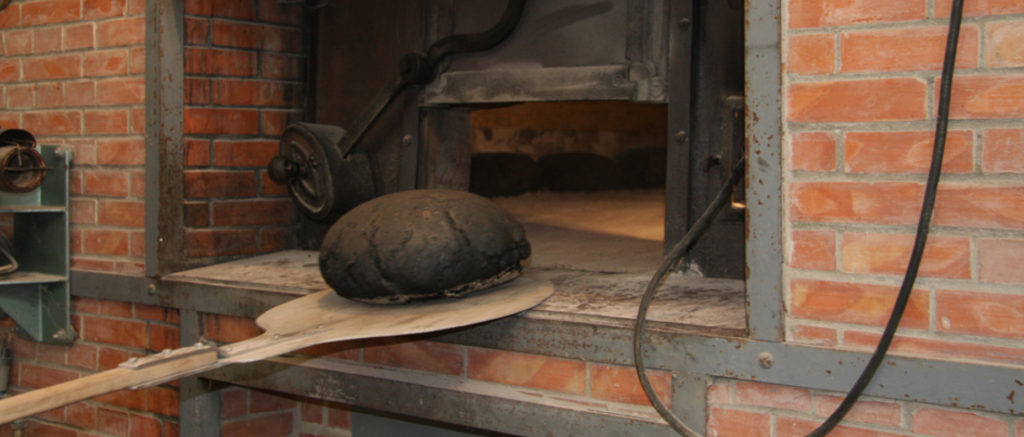In the south of France, a village of Aveyron gave its name to Roquefort: Roquefort-sur-Soulzon. It’s within this unique framework that all AOP Roquefort is made. The rock of Combalou against which this village is built, collapsed years ago, giving this region its natural riches including many caves and grottoes. It is inside one of these caves that Roquefort was invented and it is also inside one of these inhabited caves, that Papillon Roquefort takes its time to imbibe its unique flavours.
History
They say that a young shepherd, in love, was distracted by a shepherdess. Forgetting his rye bread and sheep’s cheese in the cave of Combalou where he was resting, he left to pursue the girl. A little while later, he returned to this place and discovered his meal covered in a blue-green mould. Famished, he tasted the cheese and was delighted. Roquefort, alchemy between the natural ventilation of a cave, rye bread and the cheese of the Lacaune ewes had been born.
In 1070 there is mention for the first time of Roquefort in the Carolingian texts. From then on the history of Roquefort remains closely related to Roquefort-sur-Soulzon and the Combalou mountains, thanks to King Charles VI. He decided in the 15th century, and for the first time in France, to grant exclusive production rights to the inhabitants of Roquefort, making the caves protected places. In the Century of the Enlightenment, Diderot consecrated Roquefort by awarding it the title of King of cheeses. In 1925, Roquefort became the first recognised Appellation d’Origine cheese. To date, it benefits from European recognition as Appellation d’Origine Protégée, which guarantees the provenance of a product.
There are seven producers of Roquefort. The Papillion ‘butterfly’ brand was created in 1906 by Paul Alric. The Papillion brand produce a range of different profiles of roquefort; Taste Noir being their most iconic.
Production
Step 1 : Milk is collected daily from the Lacaune breed ewes. The dairy trucks bring the milk to the cheese dairy as soon as it is collected. On its arrival, it is analysed, and stored in a tank (temperature between 28°C and 34°C).
Step 2 : The milk receives the rennet, which causes coagulation and ensures the transformation of milk into curd. This step allows the milk to thicken and gives the cheese a texture close to gel; it is the first state of all cheese.
Step 3 : A few hours after the addition of the rennet, the curdled milk is cut into small cubes then mixed in order to separate the grains of curd, which are used for the manufacture of cheese, from the lactose, also named whey.
Step 4: The curd is then poured into the moulds, which make it possible to give them a round form called bread. The Penicillium Roqueforti de Papillon, extract of rye bread baked in its oven, is then powdered over the mould.
Step 5 : The breads are turned over and drained for nearly 2 days. Then the faces and the heel of the cheeses are imprinted, dry, with coarse salt the surplus of which will be removed by brushing. Before their departure for the cave, the breads are bored through their full height to support the development of the Penicillium Roqueforti.
Step 6: There, in the half-light and the freshness of the caves, ideally aired by the fleurines, the cheese, sown with Penicillium Roqueforti, is metamorphosed slowly into Roquefort Papillon. At the end of minimum 14 days of refining, each bread is protected in a sheet of foil in which it will continue its maturation.
Rye Bread

Rye bread forms an integral part of the manufacture of Roquefort Papillon. It’s in its crumb that the Penicillium Roqueforti develops, the fungus, which gives the cheese its taste and its green and blue marbling. To preserve the tradition and entirely control the production, Papillon has had its own baker’s oven for over 40 years.
Each year in September, the Papillon baker comes to make approximately 300 rye breads which will be used for the annual production of the Penicillium Roqueforti used in the Roquefort Papillon recipe. These breads, carbonised outside, contain a still wet crumb which will be sown stock Penicillium Roqueforti Papillon. Through the change of moon, the fungus then grows in the heart of the loaves, deposited in natural caves for about 40 days. At the end of this period, they are finally opened to collect the precious fungus.


